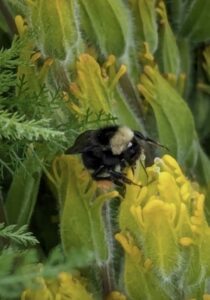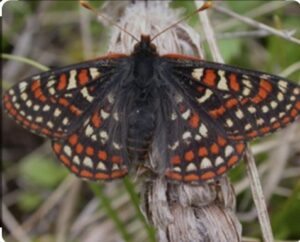Hi neighbor. My name is CALE. More commonly, I am called Golden Paintbrush, but some intellectual folks have named me Castilleja levisecta, hence the abbreviation, CALE. I am the yellow ones next to my friend Chocolate Lilly in the photo. I have an interesting story, and I hope that after reading this, you will find a place in your heart for me! I love my home here on Whidbey Island and I depend on you to make sure that I have a place to live.
 Let me take you back a few years. In 1997 I was listed as threatened under the Endangered Species Act. At that time, I had only 10 small populations left in the world ranging from southern British Columbia to Washington. My total population was about 17,000 individuals. Four of my home sites were very small populations on Whidbey Island near and along the western bluff. No one knows my historic distribution, but I did at one time live in the Willamette Valley in Oregon. Most of the places I used to live are covered with human houses and farm fields. At one time I was rather common on Whidbey Island, but of the 8000+ historic acres of open prairie, the largest unplowed piece is about 4 acres at Pacific Rim Institute.
Let me take you back a few years. In 1997 I was listed as threatened under the Endangered Species Act. At that time, I had only 10 small populations left in the world ranging from southern British Columbia to Washington. My total population was about 17,000 individuals. Four of my home sites were very small populations on Whidbey Island near and along the western bluff. No one knows my historic distribution, but I did at one time live in the Willamette Valley in Oregon. Most of the places I used to live are covered with human houses and farm fields. At one time I was rather common on Whidbey Island, but of the 8000+ historic acres of open prairie, the largest unplowed piece is about 4 acres at Pacific Rim Institute.
I am a bit of an unusual plant since, although I am green and can make some of my own food through photosynthesis, I often rely heavily on other plants. My roots connect with their roots allowing me to take some of the food they make. I am known as a hemiparasite. I can live on my own, but I do better by “sharing” with neighbors. Two of my favorite “hosts” are Oregon Sunshine (also called Woolly Sunflower) and Yarrow. You will find me often growing together with them.
I also depend on bumble bees! They are my friends, and they tickle me when they land on my flowers! They stay only long enough to stick their proboscis into the inner parts of my flower to obtain nectar. They also take my pollen and carry it to other CALE relatives and pollinate them! Here is a picture of my favorite friend, the Yellow Bumble bee.
Much has happened since I was listed as threatened in 1997. Many new populations have been established with the help of my human friends. One of the most significant is here on Whidbey Island at Pacific Rim Institute. A few of us were planted in the prairie remnant in 2001. We liked the new home! In the next few years, a few hundred more of us were planted and combined with our own strong reproduction efforts, our population at PRI began to climb. By 2021 our numbers at PRI were about 40,000 strong!!! We continued to reproduce and by 2023, our human friends in charge of the Endangered Species Act decided to de-list us! We are no longer considered threatened!!! And get this! In spring 2024, our population reached an even higher number – more than 80,000 of us. You should come out next spring in May to enjoy us at PRI. There are special tours available, and we love to have visitors. After all, we have depended on you for our survival. Thanks for your loving care!
 Oh, there is another piece of good news! I hear that my old friend Taylor’s Checkerspot Butterfly may soon be introduced at PRI. Taylor was listed as endangered on the ESA in 2013. Although I once shared prairie life on Whidbey with Taylor, the host plants for its larvae largely disappeared as did all but a few acres of essential prairie. Now with PRI’s successful prairie restoration work, Taylor again may return home. I welcome my old friend! Even though I am one of the preferred host plants for Taylor’s larvae, I am willing to share my leaves so another old friend can join us on the prairie. After all, we are in this together — if none of us take more than our fair share.
Oh, there is another piece of good news! I hear that my old friend Taylor’s Checkerspot Butterfly may soon be introduced at PRI. Taylor was listed as endangered on the ESA in 2013. Although I once shared prairie life on Whidbey with Taylor, the host plants for its larvae largely disappeared as did all but a few acres of essential prairie. Now with PRI’s successful prairie restoration work, Taylor again may return home. I welcome my old friend! Even though I am one of the preferred host plants for Taylor’s larvae, I am willing to share my leaves so another old friend can join us on the prairie. After all, we are in this together — if none of us take more than our fair share.
Sincerely, your friend and neighbor, CALE
Thanks for listening.
— Joe Sheldon
Direct comments to Joe Sheldon at jksheldon43@gmail.com
If you would like to receive more information on Creation care, notices of special events, Creation walks I lead, etc. please contact me at the above address and I will add you to my e-mail list. Your comments are welcome.


